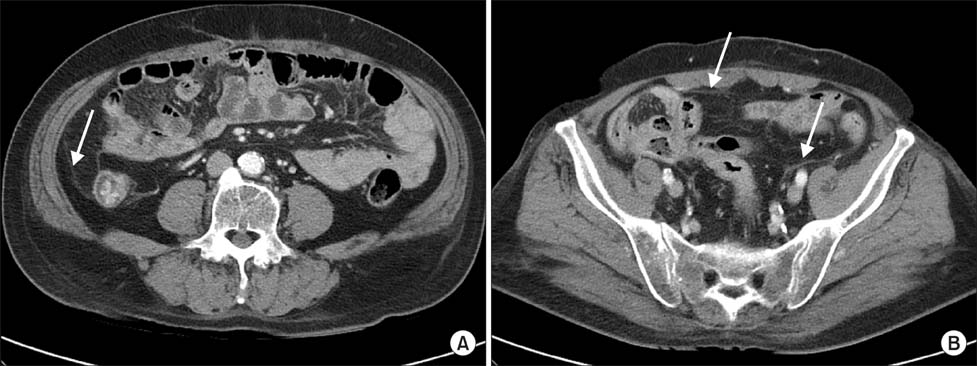Chonnam Med J.
2014 Aug;50(2):67-69. 10.4068/cmj.2014.50.2.67.
Polymicrobial Peritonitis with Lactococcus lactis in a Peritoneal Dialysis Patient
- Affiliations
-
- 1Department of Internal Medicine, Korea University Anam Hospital, Seoul, Korea. sang-kyung@korea.ac.kr
- KMID: 2172162
- DOI: http://doi.org/10.4068/cmj.2014.50.2.67
Abstract
- Lactococcus lactis (L. lactis) is an important gram-positive bacterium in dairy products. It is a rare cause of opportunistic infections with only four cases of Lactococcus peritoneal dialysis (PD) peritonitis reported in the literature. In Korea, L. lactis infection was first reported in a liver abscess patient in 2010; however, PD peritonitis with Lactococcus has not been reported in Korea. Recently, we experienced a case of Lactococcus-associated polymicrobial PD peritonitis. The patient was initially managed with broad-coverage antibiotics; however, owing to a poor response, the PD catheter was removed and the patient was switched to hemodialysis. We discuss this case and review the literature.
Keyword
MeSH Terms
Figure
Reference
-
1. Noh H. Peritoneal dialysis. Korean J Med. 2014; 86:138–141.
Article2. Li PK, Szeto CC, Piraino B, Bernardini J, Figueiredo AE, Gupta A, et al. International Society for Peritoneal Dialysis. Peritoneal dialysis-related infections recommendations: 2010 update. Perit Dial Int. 2010; 30:393–423.
Article3. Kim GC, Korbet SM. Polymicrobial peritonitis in continuous ambulatory peritoneal dialysis patients. Am J Kidney Dis. 2000; 36:1000–1008.
Article4. van Hylckama Vlieg JE, Rademaker JL, Bachmann H, Molenaar D, Kelly WJ, Siezen RJ. Natural diversity and adaptive responses of Lactococcus lactis. Curr Opin Biotechnol. 2006; 17:183–190.
Article5. Chao CT, Lai CF, Huang JW. Lactococcus garvieae peritoneal dialysis peritonitis. Perit Dial Int. 2013; 33:100–101.
Article6. Guz G, Colak B, Hizel K, Suyani E, Sindel S. Peritonitis due to Lactococcus lactis in a CAPD patient. Scand J Infect Dis. 2006; 38:698–699.
Article7. Lafrance JP, Madore F, Quérin S. Lactococcus cremoris peritonitis in a CAPD patient. Perit Dial Int. 2006; 26:716–717.
Article8. Mat O, Rossi C, Beauwens R, Moenens F, Mestrez F, Muniz MC, et al. Peritonitis due to Lactococcus cremoris in an automated peritoneal dialysis patient. Nephrol Dial Transplant. 2003; 18:2690–2691.
Article9. Kim HS, Park DW, Youn YK, Jo YM, Kim JY, Song JY, et al. Liver abscess and empyema due to Lactococcus lactis cremoris. J Korean Med Sci. 2010; 25:1669–1671.
Article10. Rostagno C, Pecile P, Stefàno PL. Early Lactococcus lactis endocarditis after mitral valve repair: a case report and literature review. Infection. 2013; 41:897–899.
Article
- Full Text Links
- Actions
-
Cited
- CITED
-
- Close
- Share
- Similar articles
-
- Effect of Lactococcus lactis 1370 on the formation of artificial plaque
- A Case of Septic Shock Following Catheter-related Infection Caused by Lactococcus lactis subsp. lactis in an Adult
- A Case of Recurrent Peritonitis Associated with Colon Cancer in a Continuous Ambulatory Peritoneal Dialysis Patient
- The Catheter Removal of Polymicrobial Peritonitis in Patients on Continuous Ambulatory Peritoneal Dialysis (CAPD)
- A Case of Rhizobium Radiobacter Peritonitis Cured without Removal of the PD Catheter in a Patient on CAPD


